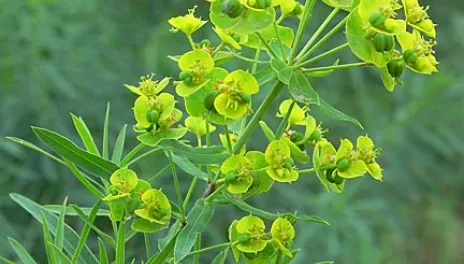Early leafy spurge management for pastures
Typically dominated by cool season grasses, the Northern Mixed Prairie range type here in North Dakota supports the highest diversity of grasses when compares to other western rangelands. The Northern Mixed Prairie also serves as host to many warm season grasses and a diverse set of forb and shrub species. Native shrubs and blue grama provide excellent winter feed for wildlife, especially during winters like this one.
Disturbances, such as wildfire (or, perhaps, the lack of fire), tillage, prolonged intense grazing pressure, and species introduction, have caused shifts in the plant communities across the Western rangelands. Post-Dirty-Thirties, grass species such as crested wheatgrass were planted to rapidly stabilize roadsides and provide early forages for livestock. Due to its early spring green-up and rapid growth, crested wheatgrass can out-compete most native grasses, and mature crested wheatgrass is not preferred by cattle due to a lack of nutrients and course stem and leaves. Similarly, Kentucky bluegrass and smooth brome have invaded most of the Northern Great Plains. Though these grass species now dominate the North Dakota prairie, some are useful as livestock feed. Other invasives have no use to livestock owners.
North Dakota has designated 13 species as noxious weeds (https://www.ndda.nd.gov/divisions/plant-industries/noxious-weeds), requiring every person to do all things necessary to control their spread. Noxious weeds cause economic and environmental loss to the state. Leafy spurge is one of North Dakota’s noxious weeds, and leafy spurge is noxious across 22 states. NDSU Extension has two publications with more information on noxious weeds: the pocket-sized W-1691 A Guide to North Dakota Noxious and Troublesome Weeds, and the full edition of W-1411 Identification and Control of Invasive and Troublesome Weeds in North Dakota .
Leafy spurge arrived from Eurasia during the 1800’s. Upon establishment, leafy spurge creates thick clumped roots which can stretch 15 feet into the soil. Spurge is a prolific seeder, producing up to 3400 pounds of seed per acre (Gucker, 2010). Cattle grazing is limited under the spurge canopy due to the creation of ingenol, a chemical compound which causes diarrhea followed by weakness in cattle.
Spurge is most susceptible to picloram during and after the true flowering stage (mid-late June and mid-September). Herbicides applications can be ineffective because of a waxy layer on leaves and because the plant can purge chemicals through its roots. NDSU Extension has published W-866 Integrated Management of Leafy Spurge and W-253-24 North Dakota Weed Control Guide with additional details on leafy spurge development and control.
Leafy spurge can be grazed by sheep and goats, but that is not an overnight success, either. Sheep will need to overcome their aversion to ingenol. During a three-year study, noticeable reductions in spurge growth was identified after two years of targeted grazing by sheep.
Leafy Spurge is susceptible to a biological control readily available to producers: flea beatle. Several species of flea beetle are available in this region. Flea beetle larvae consume spurge roots and stems, allowing opportunistic pathogens to kill the plant while adult beetles consume leaves and flowers. NDSU Extension publication W-1183 Leafy Spurge Control Using Flea Beetles discusses this option in detail.
Because of leafy spurge’s ability to regrow from extensive roots, prescribed fire alone will not suppress spurge stands. But fire can eliminate the seed bank caused by these invaders.
The combination of herbicide application, grazing, and biological and fire controls can expedite the eradication of leafy spurge. Work with your county Extension agent to develop a control plan for leafy spurge and other problem plants on your range and pasturelands.
Colin Tobin, Ph. D.
Colin.Tobin@ndsu.edu
Animal Scientist
